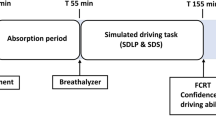Abstract
To assess the effects of cannabis on the ability required to ride a bicycle, repetitive practical cycling tests and medical examinations were carried out before and after inhalative consumption of cannabis. A maximum of three joints with body weight-adapted THC content (300 μg THC per kg body weight) could be consumed by each test subject. Fourteen regular cannabis-consuming test subjects were studied (12 males, 2 females). In summary, only a few driving faults were observed even under the influence of very high THC concentrations. A defined THC concentration that leads to an inability to ride a bicycle cannot be presented. The test subjects showed only slight distinctive features that can be documented using a medical test routinely run for persons under suspicion of driving under the influence of alcohol or drugs.






Similar content being viewed by others
References
Federal Highway Research Institute: DRUID project Final report 2012 http://www.druid-project.eu/Druid/EN/Dissemination/downloads_and_links/Final_Report.pdf?__blob=publicationFile&v=1
United Nations Office on Drugs and Crime: World Drug Report 2014 (United Nations publication, Sales No. E.14.XI.7)
Ashton H (2001) Pharmacology and effects of cannabis: a brief review. Br J Psychiatry 178:201–206
Hartung B, Kauferstein S, Ritz-Timme S, Daldrup T (2014) Sudden unexpected death under acute influence of cannabis. Forensic Sci Int 237:e11–3
Moskowitz H (1976) Marihuana: effects on simulated driving performance. Accid Anal Prev 8:45–50
Moskowitz H (1985) Marijuana and driving. Accid Anal Prev 17:323–345
Kauert GF, Ramaekers JG, Schneider E, Moeller MR, Toennes SW (2007) Pharmacokinetic properties of Δ9-tetrahydrocannbinol in serum and oral fluid. J Anal Toxicol 31:288–293
Maatz KR (2006) Driving inability after drug use. Blutalkohol 43:451–465
Drasch G, von Meyer L, Roider G, Jaegerhuber A (2003) Absolute driving inability under the influence of cannabis. Proposal Threshold Limit 40:269–286
Ramaekers JG, Berghaus G, van Laar M, Drummer OH (2004) Dose related risk of motor vehicle crashes after cannabis use. Drug Alcohol Depend 73:109–119
Grotenhermen F, Leson G, Berghaus G, Drummer OH, Krüger H-P, Longo M, Moskowitz H, Perrine B, Ramaekers JG, Smiley A, Tunbridge R (2007) Developing limits for driving under cannabis. Addiction 102:1910–1917
Hartung B, Mindiashvili N, Maatz R, Schwender H, Roth EH, Ritz-Timme S, Moody J, Malczyk A, Daldrup T (2014) Regarding the fitness to ride a bicycle under the acute influence of alcohol. Int J Legal Med. doi:10.1007/s00414-014-1104-z
Schewe G, Schuster R, Englert L, Ludwig O, Stertmann WA (1980) Experimentelle Untersuchungen zur Frage der alkoholbedingten Fahruntüchtigkeit von Fahrrad- und Mofafahrern. Blutalkohol 17:298–328
Schewe G, Knoess HP, Schaeufele A, Schuster R (1984) Experimentelle Untersuchungen zur Frage der alkoholbedingten Fahruntüchtigkeit bei Fahrradfahrern. Blutalkohol 21:97–109
Paul LD, Mußhoff F, Untergruppe “Richtlinienerstellung” des Arbeitskreises Qualitätssicherung (2009) Richtlinie der GTFCh zur Qualitätssicherung bei forensisch-toxikologischen Untersuchungen. https://www.gtfch.org/cms/images/stories/files/GTFCh_Richtlinie_For-Tox_Version%201.pdf (last access on 4th November 2015)
Hartung B, Ritz-Timme S, Schwender H, Mindiashvili N, Daldrup T (2015) Differences between male and female cyclists’ performances under the acute influence of alcohol. Int J Legal Med 129(5):1011–1020. doi:10.1007/s00414-015-1182-6
Hartung B, Schwender H, Mindiashvili N, Ritz-Timme S, Malczyk A, Daldrup T (2015) The effect of alcohol hangover on the ability to ride a bicycle. Int J Legal Med 129(4):751–8. doi:10.1007/s00414-015-1194-2
Robbe HWJ (1994) Influence of marijuana on driving. Institute for human psychopharmacology. University of Limburg, Maastricht
Acknowledgments
This study was sponsored by VEGaS e. V. (Verein zur Erforschung der Gefahren durch Drogen und andere Rauschmittel im Straßenverkehr).
Author information
Authors and Affiliations
Corresponding author
Ethics declarations
Ethical standards
The experiments of this study comply with the current German laws. The study protocol was pre-approved by the ethics committee of the University Hospital Düsseldorf.
Conflict of interest
The authors declare that they have no competing interests.
Rights and permissions
About this article
Cite this article
Hartung, B., Schwender, H., Roth, E.H. et al. The effect of cannabis on regular cannabis consumers’ ability to ride a bicycle. Int J Legal Med 130, 711–721 (2016). https://doi.org/10.1007/s00414-015-1307-y
Received:
Accepted:
Published:
Issue Date:
DOI: https://doi.org/10.1007/s00414-015-1307-y




